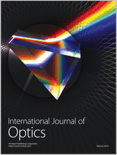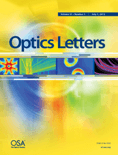
JOURNAL OF BIOMEDICAL OPTICS
Scope & Guideline
Unlocking New Frontiers in Biomedical Optics
Introduction
Aims and Scopes
- Optical Imaging Techniques:
The journal publishes research on a variety of optical imaging modalities, including optical coherence tomography (OCT), photoacoustic imaging, and fluorescence imaging. These techniques are vital for non-invasive visualization of biological tissues and structures. - Biomedical Applications:
Research in the journal often emphasizes practical applications of optical technologies in medicine, such as cancer detection, surgical guidance, and monitoring of physiological parameters, thereby bridging the gap between technology and clinical practice. - Machine Learning and AI Integration:
There is a growing focus on the incorporation of machine learning and artificial intelligence in the analysis and interpretation of optical imaging data, enhancing the accuracy and efficiency of diagnostic processes. - Phantom Development and Standardization:
The journal features studies on the development and use of tissue-mimicking phantoms for calibrating and validating optical imaging systems, which is crucial for ensuring reliable performance in clinical settings. - Multimodal Imaging Approaches:
Research often explores the integration of multiple imaging modalities, such as combining optical coherence tomography with fluorescence or photoacoustic imaging, to enhance diagnostic capabilities and provide comprehensive insights into biological processes.
Trending and Emerging
- Advancements in AI and Deep Learning:
The integration of artificial intelligence and deep learning techniques in image analysis and interpretation is a significant trend. This includes applications in automated diagnostics, image enhancement, and data analysis, which are revolutionizing the field of biomedical optics. - Non-Invasive and Wearable Technologies:
There is a notable increase in research focused on non-invasive and wearable optical devices. These technologies aim to provide continuous monitoring of physiological parameters, enhancing patient care and facilitating remote health assessments. - Photoacoustic Imaging Innovations:
Photoacoustic imaging continues to gain momentum, with emerging studies exploring its applications in cancer detection, vascular imaging, and functional imaging of tissues, underscoring its potential for real-time, high-resolution diagnostics. - Multimodal Imaging Systems:
The trend towards combining various imaging modalities, such as OCT with photoacoustic or fluorescence imaging, is on the rise. This integrated approach enhances diagnostic capabilities by providing complementary information about biological tissues. - Clinical Translation of Optical Technologies:
Research increasingly focuses on translating optical technologies into clinical practice, with an emphasis on validation studies, clinical trials, and the development of user-friendly imaging systems for healthcare applications.
Declining or Waning
- Traditional Optical Techniques:
There has been a noticeable decline in studies focusing solely on traditional optical techniques without integration with advanced computational methods or multimodal approaches, suggesting a shift towards more sophisticated imaging solutions. - Basic Research on Optical Properties:
Research that concentrates purely on the fundamental optical properties of tissues, such as absorption and scattering coefficients, has decreased. This indicates a trend towards applied research with direct clinical implications rather than theoretical explorations. - Invasive Optical Methods:
There is a waning interest in invasive optical techniques, which may be attributed to the increasing preference for non-invasive methods that enhance patient comfort and safety. - Low-Resolution Imaging Techniques:
The journal has seen fewer publications on low-resolution imaging techniques, as there is a growing demand for high-resolution imaging methods that provide detailed insights into cellular and molecular structures. - Non-Clinical Applications:
Research that focuses on optical applications outside the clinical context, such as purely experimental studies without direct relevance to patient care, appears to be declining, reflecting the journal's commitment to impactful biomedical research.
Similar Journals

JOURNAL OF MODERN OPTICS
Unveiling the Science Behind Light and VisionJOURNAL OF MODERN OPTICS, published by Taylor & Francis Ltd, stands as a prominent bi-monthly journal contributing to the fields of Atomic and Molecular Physics and Optics. With an ISSN of 0950-0340 and an E-ISSN of 1362-3044, this journal aims to disseminate high-quality research that pushes the boundaries of optical science and its applications. Since its inception in 1981, and particularly throughout its publications from 1987 to 2024, the journal has consistently published influential studies that are essential for both academic researchers and industry professionals. Ranked in the Q3 quartile for the 2023 category of Atomic and Molecular Physics and Optics, it has a Scopus ranking of #133 out of 224, indicating its steady presence and relevance in the scientific community. Although it does not offer Open Access options, readers can access its rich repository of literature that delves into innovative optical methods, technological advancements, and theoretical frameworks. The JOURNAL OF MODERN OPTICS is an indispensable resource for those seeking to advance their knowledge and research in modern optical science.

OPTICAL ENGINEERING
Advancing the frontiers of optical innovation.OPTICAL ENGINEERING, published by SPIE-SOC PHOTO-OPTICAL INSTRUMENTATION ENGINEERS, is a premier journal in the field of optical and photonic engineering, dedicated to advancing the science and technology of optics, photonics, and imaging systems. With ISSN 0091-3286 and E-ISSN 1560-2303, this esteemed publication has been contributing to the academic community since its inception in 1972, covering a wide array of topics within its converged years of operation. As a recognized entity, the journal is presently positioned in the Q3 quartile for Atomic and Molecular Physics and Optics, and in the Q2 quartile for Engineering (miscellaneous) as of 2023. The journal’s Scopus ranks reflect its impact and significance, being placed at #129 out of 307 in General Engineering and #137 out of 224 in Atomic and Molecular Physics. Although it does not operate under an open access model, the journal remains a vital resource for researchers, professionals, and students seeking the latest advancements in optical engineering. With a focus on publishing innovative research and technical advancements, OPTICAL ENGINEERING continues to be essential for driving progress in this crucial scientific field.

Optics Continuum
Fostering Collaboration in the World of OpticsOptics Continuum, published by Optica Publishing Group, is a pioneering open access journal dedicated to advancing the field of optics and photonics. Since its inception in 2022, this journal seeks to provide a vital platform for the dissemination of groundbreaking research and innovative developments across several interconnected domains, including electrical and electronic engineering, atomic and molecular physics, and material sciences focused on electronic, optical, and magnetic materials. With impressive rankings in Scopus—placed #384 in Electrical and Electronic Engineering and #109 in Atomic and Molecular Physics—the journal aims to engage a diverse readership comprised of researchers, professionals, and students, promoting collaboration and knowledge exchange. The journal's open access model ensures that cutting-edge research is readily available to all, nurturing an inclusive academic environment. For those interested in staying at the forefront of optics research, Optics Continuum is an essential resource that continuously enriches the global scientific community.

Journal of Innovative Optical Health Sciences
Illuminating Pathways in Optical Health SciencesWelcome to the Journal of Innovative Optical Health Sciences, an esteemed platform dedicated to the interdisciplinary exploration of optical technologies in health sciences. Published by World Scientific Publishing Co Pte Ltd, this open-access journal has been at the forefront of innovation since its inception in 2008, facilitating vital discussions and research advancements. With a notable impact factor and a commendable ranking in various scientific categories—including Q2 in Atomic and Molecular Physics, Q3 in Biomedical Engineering, and Q3 in Medicine (miscellaneous)—the journal serves as an essential resource for researchers, professionals, and students alike. Hailing from Singapore, we aim to bridge the gap between optical science and healthcare, promoting breakthroughs that enhance patient care and medical practices. Explore our diverse collection of studies and join a vibrant community committed to advancing knowledge in this cutting-edge field.

Current Optics and Photonics
Bridging Theory and Application in PhotonicsCurrent Optics and Photonics is a premier journal published by the Optical Society Korea, focusing on the dynamic and evolving fields of optics and photonics. With an ISSN of 2508-7266 and E-ISSN 2508-7274, it provides a comprehensive platform for scholarly communication, emphasizing innovations, advances in technology, and theoretical developments in atomic and molecular physics and optics. Situated in South Korea's vibrant academic landscape, this open access journal aims to bridge the gap between theoretical research and practical applications, fostering collaboration and knowledge sharing among researchers, professionals, and students alike. Although currently ranked in the Q3 category for both Atomic and Molecular Physics and Optics, with a Scopus rank of #183/224, it showcases significant contributions that enhance understanding in these critical areas. The journal encourages submission of original research articles, reviews, and technical notes, with the objective of driving forward the conversation in optics and photonics throughout its converged years from 2017 to 2024. Embrace the opportunity to contribute to this expanding field and become part of a community that is at the forefront of scientific discovery.

Optica Pura y Aplicada
Advancing the Frontiers of Optical ScienceOptica Pura y Aplicada, published by the SOC ESPANOLA OPTICA, stands as a vital platform for the dissemination of cutting-edge research in the fields of Atomic and Molecular Physics, Optics, and related engineering disciplines. Established in Spain, this journal aims to foster the advancement of knowledge in optical science and technology by providing a rigorous peer-reviewed publication outlet for scholars, researchers, and practitioners. Despite being categorized in the Q4 quartile across multiple domains, including Engineering and Materials Science, the journal remains committed to contributing meaningful insights and advancements within its scope. With an ISSN of 0030-3917 and an E-ISSN of 2171-8814, the journal effectively reaches a global audience eager to explore innovative applications and theoretical developments in optics and materials science. Researchers and professionals alike will find in Optica Pura y Aplicada a valuable resource for enriching their understanding and practices in an ever-evolving field, fostering collaborations and promoting research growth until its converged conclusion in 2024.

International Journal of Optomechatronics
Illuminating the path to next-generation engineering.The International Journal of Optomechatronics, published by Taylor & Francis Inc, is a leading peer-reviewed journal dedicated to the convergence of optics, mechanics, and electronics. With an ISSN of 1559-9612 and an E-ISSN of 1559-9620, this esteemed journal has been at the forefront of research in Electrical and Electronic Engineering, Instrumentation, and Mechanical Engineering since its inception in 2007. Its exceptional reputation is reflected in its Q1 rankings across multiple categories as of 2023, positioning it among the top-tier journals in the field. As an open access publication since 2017, it encourages wide dissemination of innovative research and technological advancements. With impactful contributions that span applications in robotics, control systems, and advanced manufacturing, the journal serves as a vital resource for researchers, professionals, and students aiming to remain at the cutting edge of optomechatronic science and engineering.

International Journal of Optics
Transforming Perspectives Through Optical ResearchWelcome to the International Journal of Optics, a distinguished publication dedicated to advancing the field of optics and its interdisciplinary applications. Published by HINDAWI LTD, this open-access journal has been pivotal in fostering knowledge since its inception in 2009. With a robust focus on atomic and molecular physics as well as electronic, optical, and magnetic materials, the journal has carved its niche within Q3 quartile rankings in these categories for 2023, signifying its growing impact and relevance in the scientific community. Researchers and professionals will find a rich repository of innovative and cutting-edge research articles that not only address fundamental aspects of optics but also explore practical applications across various domains. The journal's aim is to promote high-quality research dissemination, enhancing collaboration among scientists and ensuring that pivotal findings reach a global audience. Join us in exploring the dynamic world of optics—where your contributions help shape the future of science.

Neurophotonics
Revolutionizing Brain Imaging through PhotonicsNeurophotonics is a leading Open Access journal published by SPIE-SOC PHOTO-OPTICAL INSTRUMENTATION ENGINEERS, focusing on the intersection of neuroscience and photonics. Launched in 2014, this journal has rapidly ascended to achieve Q1 rankings in several categories, including Neuroscience (miscellaneous), Radiological and Ultrasound Technology, and Radiology, Nuclear Medicine and Imaging, showcasing its significant impact within these fields. With an impressive Scopus ranking of #6 in Neuroscience and #12 in Radiological and Ultrasound Technology, Neurophotonics provides a vital forum for researchers, professionals, and students dedicated to advances in optical imaging and monitoring techniques for brain research and related applications. The journal is committed to disseminating high-quality research, insights, and innovations that drive forward the understanding of neural mechanisms through light-based techniques. Accessible since 2019, it promotes wider dissemination of knowledge, making it a crucial resource for those exploring the dynamic interplay between neuroscience and optical technologies.

OPTICS LETTERS
Pioneering Innovations in Optical ScienceOPTICS LETTERS is a premier academic journal published by the Optica Publishing Group, dedicated to advancing the field of optics and photonics. Since its inception in 1977, it has maintained a strong reputation for publishing high-impact research, holding a distinguished Q1 category ranking in Atomic and Molecular Physics, as well as Optics, making it a vital resource for researchers and professionals alike. With an impressive Scopus rank of #55 out of 224 in its field, OPTICS LETTERS continues to shape the discourse and innovation in optical science. Authors benefit from its extensive international reach, while readers gain access to cutting-edge studies that address both theoretical and applied aspects of optics. Although the journal currently does not offer open access options, its rigorous peer-review standards ensure that every publication meets the highest academic criteria, making it an essential journal for anyone looking to stay at the forefront of optical research.